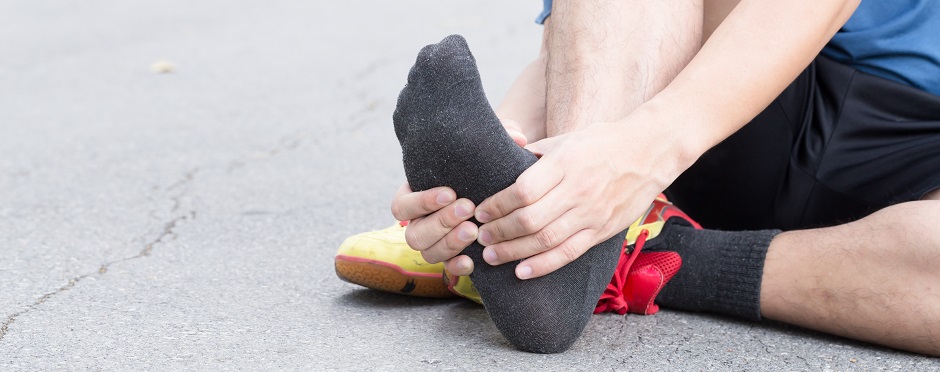
Can Dry Needling Help Plantar Fasciitis?
1 CommentTaut bands can exist within your body that disrupt blood flow to your muscles. The affected area can become an acidic environment and begin to radiate pain elsewhere in the body. Trigger points are when those taut bands start to refer pain elsewhere. A technique called dry needling can help with this referred or local pain. Dry needling is a skilled intervention that uses a thin filiform needle to penetrate the skin and release underlying myofascial trigger points, muscular and connective tissues. It can help manage neuromusculoskeletal pain and movement impairments. Dry needling is used for a variety of diagnoses, from headaches and migraines to low back pain. This helpful technique is also a treatment option for plantar fasciitis. This condition often affects endurance athletes.
Referred Pain – Inflammation or Trigger Points?
Plantar fasciitis is an inflammation of the band of tissue running along the underside of
the foot/arch. While inflammation could be causing the pain, often overlooked culprits are the trigger points in the Gastrocnemius and Soleus muscles (aka calf muscles). Someone suffering from plantar fasciitis may feel heel pain at attachments by the heel or by the toe or throughout the arch of the foot. People with plantar fasciitis – especially endurance athletes – may have pain associated with initial ambulation in the morning, after prolonged sitting, or with prolonged walking or standing, especially when barefoot.
Dry Needling’s Effect on the Central Nervous System
Along with eliminating trigger points in the muscle, trigger point dry needling is known to
stimulate neural pathways to block pain by disrupting pain messages being sent to the central nervous system. This means that dry needling may not just be a short-term fix of your plantar fasciitis. Relief can last for several days. When combined with other corrective exercises and treatment interventions, dry needling plus other physical therapy treatment can eliminate plantar heel pain.
The Research
A July 2021 Meta-Analysis of 297 randomized control trials (RCTs) suggested that trigger point dry needling positively effects those with plantar heel pain of a musculoskeletal origin.3 (Meta-Analyses are often considered one of the highest levels of evidence as they reference multiple randomized control trials to unearth a common result or theme.)
A 2016 study also suggested that trigger point dry needling can effectively reduce pain and is a good option to consider before undergoing more invasive therapies or procedures. Additional studies also indicate that trigger point dry needling can resolve pain and reduce symptoms more quickly than traditional methods. In one study regarding patients with heel pain, the control group required 21 weeks on average to relieve their pain, while the dry needling group resolved their pain in just three weeks!5,6
When You’ve Tried Everything Else
Dry needling has helped patients who have tried the usual remedies: stretching, foam rolling, Instrument-Assisted Soft Tissue Mobilization, etc., but found minimal relief. If you feel this is a treatment that may benefit you, contact your nearest Athletico and talk to one of our dry needling trained clinicians to get started. When it comes to getting back on your feet and conquering some miles or simply walking without pain, it can all start with Athletico. Schedule a Free Assessment today. Free Assessments are available in-clinic and virtually through our Telehealth platform.
The Athletico blog is an educational resource written by Athletico employees. Athletico bloggers are licensed professionals who abide by the code of ethics outlined by their respective professional associations. The content published in blog posts represents the opinion of the individual author based on their expertise and experience. The content provided in this blog is for informational purposes only, does not constitute medical advice and should not be relied on for making personal health decisions.
References:
1. https://www.bmechanics.com/blog/my-experience-dry-needling-how-it-help-me-get-throu
gh-half-marathon
2. http://dovepress.com/trigger-point-dry-needling-for-the-treatment-of-myofascial-pain-syn
dro-peer-reviewed-fulltext-article-JPR
3. https://pubmed.ncbi.nlm.nih.gov/33760098/
4. https://www.ncbi.nlm.nih.gov/pmc/articles/PMC5038993/
5. https://rehabrenegade.com/plantar-fasciitis-think-again/
6. https://www.jospt.org/doi/10.2519/jospt.2014.0303

1 Comment
barbara
The meta- analysis referenced in #3 above, included only 6 studies. 297 were screened. Results in the abstract report caution.
” Moderate- to low-quality evidence suggests a positive effect of trigger point dry needling for improving pain intensity and pain-related disability in the short term and long term, respectively, in patients with plantar heel pain of musculoskeletal origin. The present results should be considered with caution because of the small number of trials.”